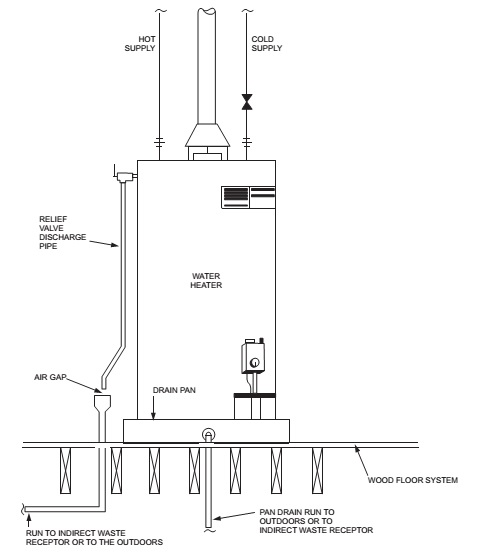A water heater drain pan not draining can indicate a clog or improper installation. Addressing this issue quickly prevents water damage.
A water heater drain pan plays a crucial role in preventing water damage in your home. It collects any leaking water from the water heater, directing it to a proper drainage system. If the pan is not draining, it can lead to significant problems, including mold growth and structural damage.
Common causes include blockages in the drain pipe or incorrect installation. Regular maintenance and prompt troubleshooting are essential to ensure the drain pan functions correctly. Understanding these issues helps homeowners take timely action, safeguarding their property and ensuring the longevity of their water heater system.

Credit: codes.iccsafe.org
Page Contents
Common Causes
A clogged drain can stop the water from flowing. Small pieces of debris and dirt often cause the clog. Mineral buildup is another reason for a blocked drain. Keeping the area clean helps in avoiding clogs. Regular maintenance is essential for a smooth drain.
Improper installation can cause drainage problems. The drain pan must be placed correctly. Ensure the drain pipe is the right size. An uneven surface can also lead to issues. Hiring a professional can help in proper installation. Always check the work for any mistakes.
Essential Tools
A plunger is useful for unclogging drains. It creates suction to remove blockages. Place the plunger over the drain. Push and pull it to create pressure. This can help to clear minor clogs.
A pipe wrench is vital for loosening and tightening pipes. It has strong jaws to grip the pipes. Adjust the wrench to fit the pipe size. Turn the wrench to loosen or tighten the pipe. Be careful not to damage the pipes with too much force.
Initial Inspection
Leaks can cause big problems. Look at the water heater closely. See if there is any water around it. Pay attention to wet spots on the floor. Wet spots mean there might be a leak. Check the pipes and connections too. Small drips can turn into big leaks. Fixing leaks quickly is very important.
The drain pan should be clean. Make sure there is no debris in it. Debris can block the pan and cause water to spill. Look at the drain pipe connected to the pan. Ensure it is not clogged. Water should flow freely through the pipe. A clean drain pan helps prevent flooding.
Clearing The Clog
A plunger can help clear clogs in your water heater drain pan. Place the plunger over the drain hole and push and pull to create suction. This action can dislodge debris blocking the drain. Make sure to create a tight seal with the plunger for best results. Repeat this process until water begins to drain properly. If this doesn’t work, try another method.
Chemical drain cleaners can dissolve clogs in your water heater drain pan. Pour the cleaner into the drain and wait for it to work. Follow the instructions on the cleaner’s label for the best results. Use these cleaners with caution as they contain strong chemicals. Always wear protective gloves and ensure the area is well-ventilated. If the clog persists, consult a professional.
Fixing Installation Issues
Experiencing issues with your water heater drain pan not draining? Address potential blockages or improper installation to prevent water damage effectively. Ensure a seamless flow by regularly inspecting and maintaining your drain pan setup.
Leveling The Pan
Make sure the drain pan is level. An uneven pan can cause water to pool. Use a bubble level tool to check. Adjust the pan by adding shims under it. Shims are small pieces of wood or plastic. They help lift one side of the pan. This ensures the pan stays flat. A level pan helps water flow to the drain.
Ensuring Proper Alignment
Check the alignment of the drain pan. The drain hole should match the drain pipe. Misalignment can block water flow. Move the pan to align it correctly. Tighten any loose connections. A well-aligned pan prevents leaks. It also ensures efficient draining.

Credit: www.reddit.com
Preventive Maintenance
Regular cleaning of the water heater drain pan is important. Dust and debris can block the drain. Use a vacuum to clean the pan. A clean drain pan prevents clogs. Check the pan every month. Clean any dirt or buildup found. A clean pan helps water flow easily.
Inspecting connections helps keep your water heater working well. Loose connections can cause leaks. Check the pipes and fittings. Tighten any loose parts with a wrench. Look for rust or wear on the pipes. Replace damaged parts right away. Regular inspection prevents bigger problems.
When To Call A Professional
If your water heater drain pan is not draining, it can cause serious problems. Regular checks are important. Sometimes, clogs happen due to debris or sediment buildup. Persistent issues may need a professional touch. Experts have the right tools and know-how to fix it. Ignoring this problem can lead to water damage. Always keep an eye on your drain pan’s condition. If issues continue, call a professional.
Some water heater issues are too complex to handle alone. Complex repairs need special skills and tools. Attempting these repairs without expertise can make things worse. Professional plumbers know how to handle these situations. They can diagnose the problem quickly. They also ensure repairs are done safely. Always trust professionals for complex repairs to avoid further damage.
Choosing A New Drain Pan
A water heater drain pan not draining properly can lead to significant water damage. Opt for a new, high-quality drain pan to ensure efficient water flow and protection.
Material Options
Drain pans come in different materials. Plastic pans are light and cheap. They are easy to install but can crack. Metal pans are strong and last longer. They are good for heavy water heaters. Aluminum pans are rust-proof and lightweight. Steel pans are very durable but can rust over time. Fiberglass pans are strong and do not rust. Each material has its own benefits.
Size Considerations
The drain pan must fit the water heater. Measure the base of the heater first. Leave some extra space for water to collect. Check the height of the pan’s sides too. Higher sides can hold more water. Make sure the pan fits the space where the heater sits. A good fit helps prevent leaks.

Credit: www.reddit.com
Frequently Asked Questions
Why Is My Water Heater Pan Full Of Water?
Your water heater pan might be full due to a leak, faulty valve, or condensation. Check for damage immediately.
Why Is My Drain Water Heater Not Draining?
Your drain water heater may not be draining due to a clogged valve, sediment buildup, or a faulty drain valve. Regular maintenance can prevent these issues.
How Do You Unclog A Water Heater Drain Line?
Turn off the heater and water supply. Attach a hose to the drain valve. Open the valve and flush out debris.
Why Is My Furnace Drain Pan Full Of Water?
Your furnace drain pan is full of water due to a clogged condensate drain or a broken condensate pump. Fixing these issues can prevent water damage.
Conclusion
Addressing a water heater drain pan issue promptly is crucial. It prevents water damage and costly repairs. Regular maintenance and inspection can help. Always consult a professional for persistent problems. Keep your home safe and your water heater functioning efficiently by staying proactive.
